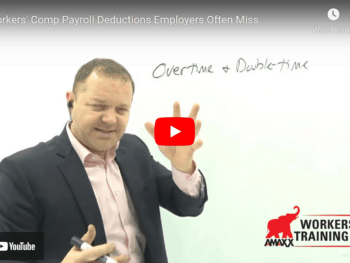A second injury fund can be an employer’s best friend. A second injury fund reimburses the insurer, or the employer if self-insured, part or all of the cost of a workers compensation claim if the employee is already partially disabled prior to the occurrence causing the work comp claim. Second injury funds (also known as subsequent injury funds) exist in about 20 states. If your state has a second injury fund/subsequent injury fund you need to know to know how the fund works.
1) Purpose
The purpose of second injury funds is to encourage employers to retain disabled employees or hire employees with disabilities. Second injury funds protect the employer from the additional cost of a workers compensation claim that combines a new injury and prior disability. The cost of medical care and the length of time off work can be substantially greater due to the preexisting condition when a disabled employee incurs an injury while on the job. The second injury fund offsets the additional cost the insurer or self-insured employer would incur because they retained an employee with a prior disability or hired a new employee with a preexisting disability.
Click Link to Access Free PDF Download
“Workers’ Comp Claims Review Checklist: 9 Must-Have, Serious-Impact Elements”
An Example
A typical example of a second injury fund claim is the employee who does manual labor. The employee ruptures two disc in his back while working for his first employer. The employee settled the workers comp claim, but due to a 25% permanent partial disability rating the employee is unable to return to work for the first employer.
The second employer has less strenuous work the employee can do within the limitations set by the work comp doctor. The second employer is impressed with the employee’s qualifications and hires the employee knowing the employee has a preexisting disability. (In most states with second injury funds, in order for the insurer or self-insured employer to be reimbursed by the second injury fund, the employer must have retained the employee after a prior injury or the employer must know of the employee preexisting disability at the time of hiring).
The employee is injured again. The disability is greater than it would have been had the employee not had the preexisting disability. The second injury fund reimburses the insurer or the self-insured employer the additional cost over and above what the workers comp claim cost would have been except for the prior disability.
2) Permanent Partial Disability
Some states try to define precisely what preexisting disabilities will be considered and will have a list of disabilities including prior amputation, various diseases, spinal fusion, mental deficiency, etc. Other states will accept a medical diagnosis stating a precise permanent partial disability with the most common being musculoskeletal disorders from prior injuries.
3) Fund Management
In most states having a second injury fund, the fund is operated as a department or division within the Industrial Commission or Workers Compensation Board. The fund is financed by an assessment against each work comp insurer, self-insured, group or pool providing work comp coverage within the state. Depending on the state, the assessment is based either on the total work comp premium or the total of work comp benefits paid.
Some states, for example Ohio, require the employer to report the employee’s disability to the second fund injury fund prior to an injury occurring. The fund requires the employee to be on their list of disabled employees before an injury occurs for the insurer or the self-insured employer to be eligible for second injury fund reimbursement.
4) Disabled Employees
Employers are often unwilling to take the risk of hiring an employee with a preexisting permanent partial disability. The employer knows the cost of a workers comp injury is often significantly greater for the employee who has a preexisting disability. The second injury fund is designed to mitigate the additional cost of the workers comp injuries that do occur.
Disabled employees are usually more cautious and safety conscious than the average employee because the disabled employee fears becoming further disabled due to an injury. With proper job placement that takes into consideration the qualifications of the employee and a proper safety program, the risk of injury to a disable employee is normally lower than the risk of injury to other employees.
5) Nature of Prior Injury
Most states with a second injury fund do not require the original injury or illness that caused the employee’s disability to be work related. The preexisting disability can be the result of a prior work comp injury, but it can also be the result of a non-work related injury, or a non-work related illness or congenital disorder.
6) Making A Claim
When the insurer or self-insured employer becomes aware of a new injury to the employee who already has a disability, the insurer or the self-insured employer files a notice or claim form with the second injury fund. Most states have time limitations on the filing of a second injury claim. The request for reimbursement of the workers comp claim must be filed within a year of the occurrence of the workers comp claim injury in most states. Be sure to check with your state on the time limitations as soon as you become aware of a claim qualifying for second injury fund reimbursement.
The claim for reimbursement must be documented with:
- proof the employer knew of the disability prior to the work comp injury,
- the nature of the prior disability,
- the medical diagnosis, prognosis and disability rating for the work comp injury,
- proof the second injury would not have occurred but for the preexisting disability (in most states with second injury funds)
7) Fund Payments
The amount of workers comp claim reimbursement by a second injury fund varies by the state where the fund is located. Typical benefits reimbursed are:
- 50% of all necessary medical expenses, or the amount of medical expenses over and above what would have been incurred by an employee without a preexisting disability, or all medical expenses over a set figure – for example all medical expenses over $10,000.
- All indemnity benefits after the first two years, or the amount of indemnity benefits over and above what would have been paid to an employee without a preexisting disability.
- In death claims all death benefits after 2 years (or other time frame set by the individual state)
Summary
Second injury funds were created to encourage employers to hire or retain disable workers. They try to accomplish this be offsetting part or all of the additional cost associated with the workers comp claim of a person with a prior disability. Every insurer or self-insured employer needs to understand the second injury fund process in their state in order to minimize the cost of the workers comp claims of employees with prior disabilities.
Author Rebecca Shafer, J.D., President, Amaxx Risks Solutions, Inc. has worked successfully for 20 years with many industries to reduce Workers’ Compensation costs, including airlines, healthcare, printing/publishing, pharmaceuticals, retail, hospitality and manufacturing. Contact: Info@ReduceYourWorkersComp.com or 860-553-6604.
Do not use this information without independent verification. All state laws vary. You should consult with your insurance broker or agent about workers’ comp issues.
©2010 Amaxx Risk Solutions, Inc. All rights reserved under International Copyright Law.













